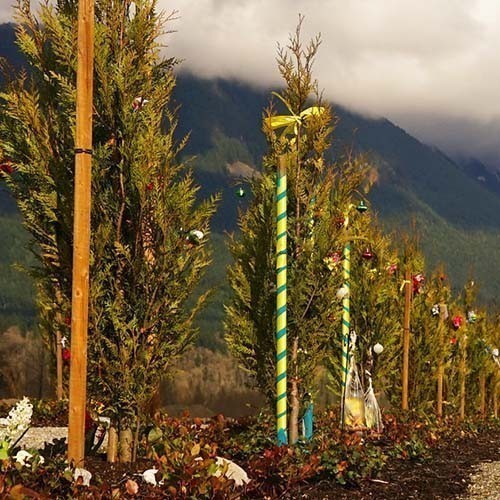
©Wolfram Burner, 2015. Trees at the landslide memorial represent the 43 people who died.
Last We Knew: In March 2014, weeks of rainfall in Oso, Washington, sent a massive debris flow plummeting downslope to bury a mile-wide swath of the valley below. The landslide demolished the community of Steelhead Haven and claimed 43 lives. Within a week, the Seattle Times published an analysis that damned state regulators for not protecting land near the slide site from ecologically unsound logging practices.
The analysis pointed to a 1997 report geologic report that delineated where ground water could leach into the slope and create a landslide risk. Despite lauding the report as state of the art and using it to issue logging restrictions, the Washington State Department of Natural Resources later approved clear cutting (a practice that removes all or most trees from an area) on about five acres that should have been protected, according to the Seattle Times report. Removing trees, which absorb rainfall, can lead to excess water seepage and destabilize the landscape.
While the analysis seemed damning, scientists said they couldn't be sure of exactly what role logging played in the disaster. The area has a long history of both logging and landslides, and while there are widely acknowledged links between the logging industry and shallow debris flows, the Oso slide was deep.
“I can't even put my finger on a really clear, defensible, definitive study that says ‘Yes, logging matters for deep-seated landslides,’” Josh Roering, a University of Oregon, Eugene expert on logging and landslides, told National Geographic News at the time.

©U.S. Geological Survey, 2014. An aerial survey showing the extent of the March 2014 landslide in northwest Washington.
The Latest: The two-year anniversary of the landslide passed recently without much fanfare, although evidence of the slide is still apparent in the landscape and the community. Meanwhile, several scientific investigations have been made into the disaster, with outcomes leaning toward ruling the slide more natural than manmade.
“One study I co-led identified geologic factors such as weak, saturated ground that made the Oso hillside highly susceptible to landslides,” writes University of Washington geotechnical engineering professor Joseph Wartman in The Conversation. “Another investigation found that large landslides similar to the one in Oso occur with surprising frequency in the region…”
Neither of the reports, nor a 2015 report by U.S. Geological Survey scientists, find that logging activities in the area contributed significantly to the disaster, however, the USGS stated that the landslide’s “mobility may have been far less if the landslide material had been slightly denser and/or drier.”
Coming Up: The need for continued evaluation of the studies is delaying a civil trial that would determine if anyone was at fault in the landslide, according to the Everett Washington Herald.
“The analysis of what contributed to the Oso landslide, and just as importantly what factors did not contribute, is not surprisingly an incredibly complex analysis requiring a multidisciplinary team to fully evaluate the event,” the Herald quotes Rene Tomisser, senior counsel for the state attorney general's office, as stating.
The suit, filed on the behalf of the 43 victims and those injured in the landslide, is now slated for September.
Jolie Breeden is the lead editor and science communicator for Natural Hazards Center publications. She writes and edits for Research Counts; the Quick Response, Mitigation Matters, Public Health, and Weather Ready Research Award report series; as well as for special projects and publications. Breeden graduated summa cum laude from the University of Colorado Boulder with a bachelor’s degree in journalism.